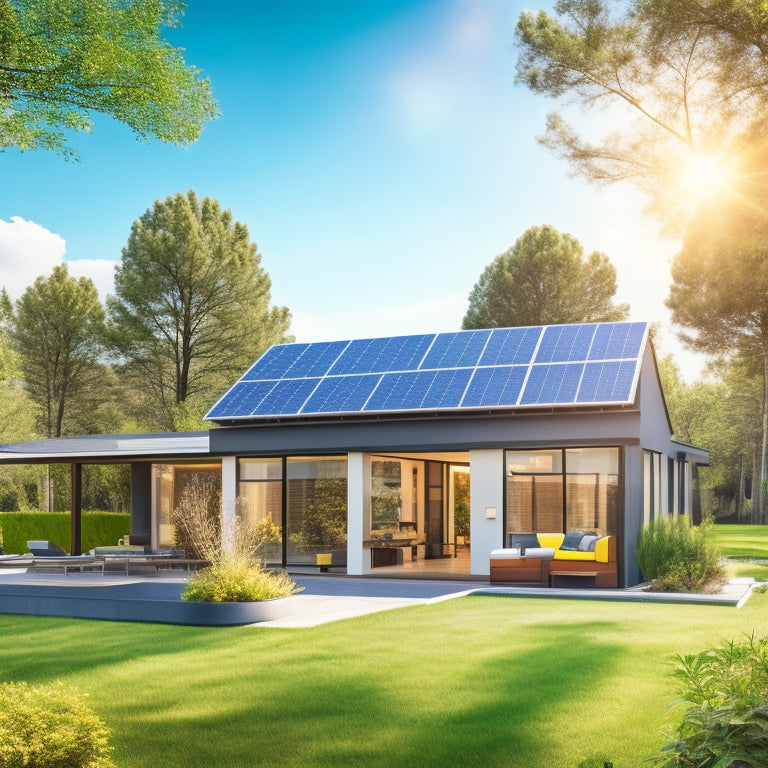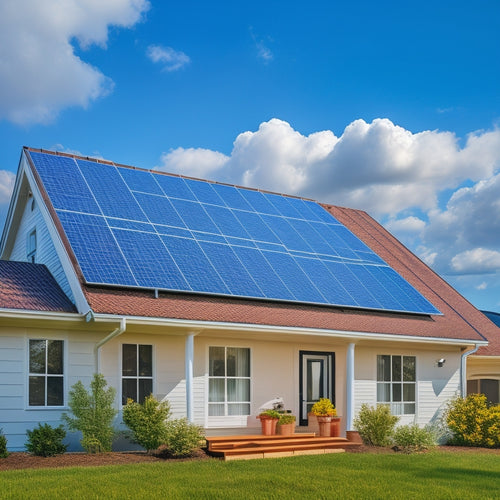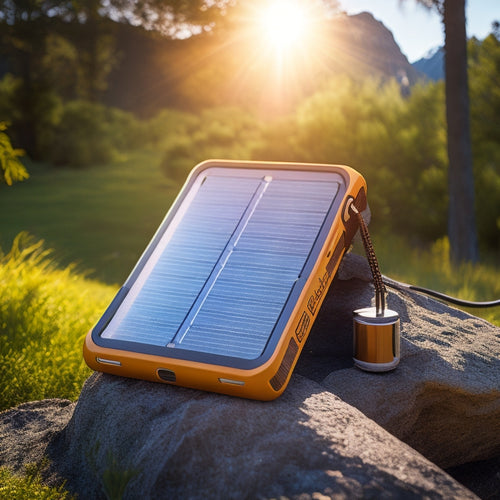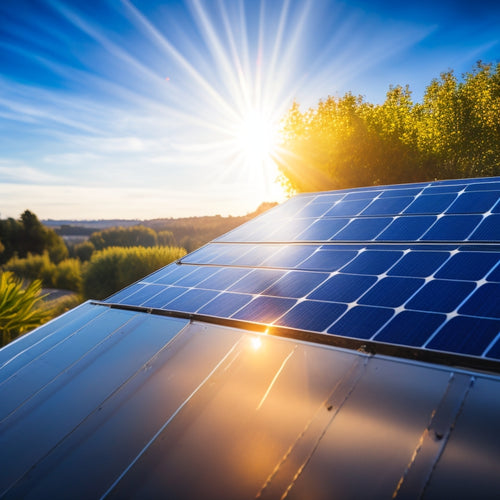
Solar Panels for Your House
Share
You're considering installing solar panels on your house, a decision that can greatly reduce your energy bills and carbon footprint while increasing your property's value. With solar panels, you can cut energy costs, enjoy financial freedom, and even sell excess energy back to the grid. Plus, solar installations enhance your property's selling price, making it more desirable to eco-conscious buyers. By understanding roof conditions, panel placement, and energy management, you can maximize energy output and efficiency. Now, explore how to optimize your solar panel system and access its full potential.
The Essentials
- Solar panels can significantly reduce your energy bills by generating free electricity and reducing your reliance on the grid.
- Installing solar panels can increase your property value, making it more attractive to eco-conscious buyers and potentially selling for up to 17% more.
- Solar energy is a clean and sustainable way to reduce your carbon footprint, equivalent to planting 24 trees or removing 2 cars from the road.
- Strategic panel placement and energy management can maximize energy output, and excess energy can be stored for use during non-sunny hours.
- Government incentives and net metering can further offset the cost of solar panel installation, making it a more affordable and lucrative investment.
Zero Energy Bills Guaranteed
With a solar panel system, you'll cut energy costs by generating free electricity and reduce your reliance on the grid.
By doing so, you'll also greatly shrink your carbon footprint, contributing to a cleaner environment.
By investing in Solar Power and Battery Storage solutions, you can break free from reliance on the grid and reduce your electricity bills, allowing you to reap considerable cost savings while taking control of your energy needs Renewable Energy Solutions.
Cut Energy Costs
Your electricity meter starts running backwards when you install solar panels on your house. This means you're generating more energy than you're consuming, and your utility company is crediting you for the excess.
With solar panels, you can greatly cut energy costs and enjoy the financial freedom that comes with it. By integrating a battery storage system into your solar setup, you can store excess energy generated during the day to use at night or during power outages, and gain more control over your energy bills Energy Storage Solutions.
To maximize your energy savings, consider these energy saving tips: optimize your panel's angle and direction, use energy-efficient appliances, and turn off lights and electronics when not in use.
You can also take advantage of utility incentives, such as net metering, which allows you to sell excess energy back to the grid and offset your consumption during periods of low energy production.
Reduce Carbon Footprint
Reduce Carbon Footprint (Zero Energy Bills Guaranteed)
Every kilowatt-hour of solar energy you produce reduces your reliance on fossil fuels, cutting greenhouse gas emissions and shrinking your carbon footprint. By utilizing the power of the sun, you're taking a significant step towards sustainable living and reducing your impact on the environment. With solar panels, you're not only saving money on your energy bills but also contributing to a cleaner, healthier planet.
| Emissions Reduction | Environmental Benefits | Sustainable Living |
|---|---|---|
| 1 ton of CO2 | Equivalent to planting 24 trees | Reduced air pollution for a healthier community |
| 2 tons of NOx | Equivalent to removing 2 cars from the road | Cleaner air and water for future generations |
| 1 ton of SO2 | Equivalent to saving 1 acre of forest | Preserving natural resources for a sustainable future |
Increased Property Value Boost
When you install solar panels on your house, you can expect a significant increase in your property's value.
In fact, studies have shown that homes with residential solar installation solar power system tend to have higher selling prices due to the appeal of renewable energy and reduced energy costs.
Additionally, solar panels can also lead to effective home energy savings and reduced bills.
This enhancement in value will make your home more attractive to potential buyers, giving you a competitive edge in the market.
Higher Selling Price
Installing solar panels on your house can greatly enhance its selling price, as eco-conscious homebuyers are willing to pay a premium for properties with sustainable energy systems.
This increased demand translates to a higher selling price, which means you can reap the benefits of your investment. According to market trends, homes with solar panels sell for up to 17% more than similar homes without them.
This significant increase in home equity can be a transformative factor for homeowners looking to sell their property. With solar panels, you can attract more buyers and negotiate a better sale price, giving you more freedom to pursue your goals.
Attractive to Buyers
Since you're considering investing in solar panels, it's essential to understand how they can make your property more attractive to potential buyers. A significant benefit of solar panels is their impact on buyer perception. According to market trends, homes with solar panels are more desirable and attractive to buyers.
| Feature | Benefit |
|---|---|
| Energy Efficiency | Reduced energy bills and carbon footprint |
| Environmental Benefits | Contribution to a sustainable future |
| Increased Property Value | Higher selling price and increased buyer interest |
| Low Maintenance | Reduced maintenance costs and extended lifespan |
| Government Incentives | Eligibility for tax credits and rebates |
Efficient Energy Harvesting System
You want to maximize your solar panel system's energy output, which requires a thorough understanding of your roof's unique conditions and the best placement of panels to capture sunlight.
By strategically positioning panels to minimize shading and enhance angles, you can greatly increase your system's energy production.
To achieve this, you'll need to assess your roof's orientation, slope, and potential obstructions to determine the ideal panel configuration.
Additionally, it's crucial to take into account energy efficiency and sustainable power solutions to get the most out of your solar panel installation.
Maximizing Energy Output
Every hour, your solar panels are exposed to a significant amount of sunlight, and it's crucial to make the most of this energy efficiently. To maximize energy output, you need to confirm your solar panel orientation is optimized. This involves adjusting the angle and direction of your panels to capture the most sunlight throughout the day.
During winter months, the sun is lower in the sky, so your panels should be tilted at a steeper angle to compensate. In the summer, when the sun is higher, a shallower angle is more effective.
Seasonal energy variations also play a significant role in maximizing energy output. As the Earth's axis tilts, the amount of sunlight your panels receive changes. By understanding these variations, you can adjust your energy usage and storage accordingly.
For instance, you may want to store excess energy generated during the summer months for use during the winter when energy production is lower. By optimizing your solar panel orientation and accounting for seasonal energy variations, you can confirm you're getting the most out of your solar panels and enjoying the freedom that comes with renewable energy.
Optimal Panel Placement
Ideal panel placement is critical to creating an efficient energy harvesting system. You want to guarantee that your solar panels are positioned to maximize energy output, and that means considering several key factors.
First, think about panel orientation. In the northern hemisphere, a south-facing orientation is usually ideal, as it allows your panels to absorb the most direct sunlight. However, if your roof doesn't have a suitable south-facing slope, don't worry – you can still achieve good results with an east- or west-facing orientation.
Next, consider the installation angle. This refers to the tilt of your panels relative to the roof's surface. A steeper angle can be beneficial in areas with heavy snowfall, as it allows snow to slide off more easily.
In general, an installation angle between 30 and 40 degrees is a good starting point. By optimizing panel placement, you can increase energy production and reduce the overall cost of your solar panel system.
Check Your Roof's Shading
When evaluating your roof's suitability for solar panels, you'll need to identify obstructions that can cast shade on the installation.
You should consider permanent features like skylights, vents, and chimneys, as well as temporary ones like tree branches.
In addition, it's important to assess your energy efficiency solutions and off-grid energy options to maximize the benefits of solar power for your home.
For instance, you can investigate renewable energy systems that can help reduce your utility bills.
You'll also need to analyze shading patterns over time, considering the sun's path across the sky throughout the day and year.
Roof Obstructions to Consider
Evaluating your roof's shading is essential in determining the suitability of solar panels for your house.
You'll need to identify any obstructions that could impact the performance of your solar panel system. Start by reviewing your roof's orientation - is it east-, west-, north-, or south-facing? This will help you determine the best placement for your solar panels.
Next, look for installation obstacles such as skylights, vents, or chimneys. These features can cast shadows on your roof, reducing the amount of sunlight that reaches your solar panels.
You'll need to decide whether to work around these obstructions or consider relocating them.
Additionally, consider the impact of surrounding structures, such as neighboring buildings or trees, on your roof's shading. These can also cast shadows, affecting the performance of your solar panels.
Shading Patterns Over Time
You've assessed your roof's orientation and identified potential obstructions, now it's time to examine the shading patterns on your roof over time. A thorough shading analysis is essential to determine the ideal placement of your solar panels.
Seasonal variations greatly impact the amount of shade your roof receives. During winter, the sun is lower in the sky, causing longer shadows, while in summer, the sun is higher, resulting in shorter shadows. You'll need to take into account these changes when evaluating your roof's shading patterns.
Use a shading analysis tool or consult with a solar panel professional to identify areas of your roof that receive partial or full shade throughout the day. This will help you determine the best locations for your solar panels to guarantee maximum energy production.
Don't forget to take into account the movement of trees and other obstructions throughout the year, as their shadows can affect your solar panels' performance. By understanding your roof's shading patterns, you can enhance your solar panel system's design and maximize your energy independence.
Higher Energy Conversion Rate
You want to maximize your solar panel's energy conversion rate to get the most out of your investment.
A higher energy conversion rate translates to a higher maximum power output, which is essential for offsetting your electricity bills.
Maximum Power Output
As the solar panel system's energy conversion rate directly impacts your electricity bill, achieving maximum power output is vital. You want to maximize the energy generated from your solar panels to reduce your reliance on the grid and minimize your electricity costs.
To achieve maximum power output, you need to focus on panel efficiency. High-efficiency solar panels convert more sunlight into electricity, resulting in higher power output. Look for panels with high efficiency ratings, typically above 20%.
Another significant factor is the installation angle. The angle at which your solar panels are installed affects the amount of sunlight they receive. A tilt angle between 30° and 40° is usually ideal, but this may vary depending on your location and the time of year.
Verify your installer assesses your roof's orientation and recommends the perfect installation angle for maximum power output. By prioritizing panel efficiency and ideal installation angle, you'll be able to generate more electricity and enjoy greater energy independence.
Frequently Asked Questions
Can Solar Panels Be Installed on Mobile Homes?
You're wondering if solar panels can be installed on your mobile home. While it's technically possible, you'll face unique installation challenges, such as ensuring your mobile home's structure can support the added weight and finding a suitable rooftop configuration.
How Long Do Solar Panel Warranties Typically Last?
You'll find that warranties typically last between 25 to 30 years, with some manufacturers offering longer warranty coverage. There are two main warranty types: product warranties covering panel defects and performance warranties guaranteeing energy output.
Do Solar Panels Require Regular Maintenance Checks?
You'll be interested to know that 85% of solar panels still operate at 90% capacity after 25 years. To guarantee peak performance, you'll want to perform regular maintenance checks, including performance monitoring and cleaning every 6-12 months, to maximize energy output and extend lifespan.
Can Solar Panels Be Used With Septic Systems?
You'll be glad to know that your septic system won't hinder your switch to renewable energy, as solar panels are compatible with septic systems, ensuring energy efficiency and freedom from traditional power grids.
Are Solar Panels Resistant to Hail and Extreme Weather?
You need to know that solar panels are built to withstand hail resistance and extreme weather conditions; they're designed with durable materials and undergo rigorous testing to guarantee they can handle harsh environmental factors without compromising performance.
Final Thoughts
As you utilize the power of the sun, your home evolves into a self-sustaining oasis, where energy independence flourishes. With solar panels, you'll bask in the glory of zero energy bills, and your property value will skyrocket like a shooting star. The efficient energy gathering system will have you generating power like a well-oiled machine, while the shading check guarantees your roof is optimized for maximum energy absorption. And with a higher energy conversion rate, you'll be glowing with satisfaction, knowing you're doing your part for the environment.
Related Posts
-

Cost of Solar Panel Installation
You can expect to pay between $15,000 and $30,000 or more for a typical solar panel installation, depending on the sy...
-

Fastest Solar Chargers for Emergency Power
When choosing the fastest solar chargers for emergency power, you need to focus on features like rapid charging capab...
-

How Efficient Are Thin Film Solar Cells
Thin film solar cells provide an innovative approach to energy generation, boasting efficiency rates generally betwee...


